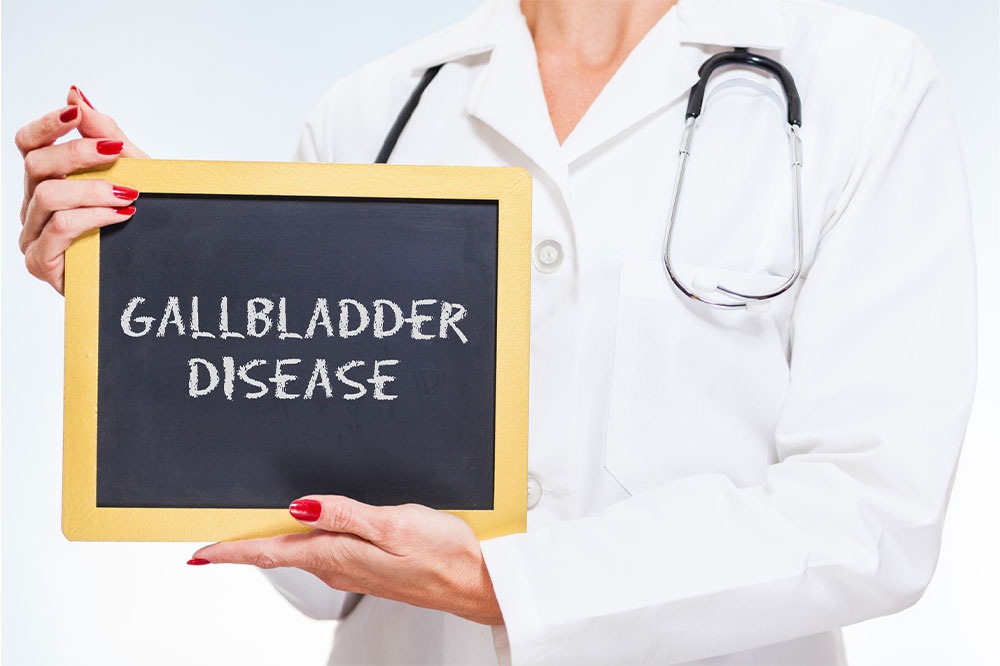
Gallbladder disease – Its symptoms, causes, and management
The gallbladder is one of those organs in the body that most people generally don’t pay attention to until it starts acting up. It is a small pouch that sits right under the liver in the upper-right section of the abdomen. It stores bile, a combination of fluids, fat, and cholesterol, produced by the liver. Read on to learn about the function of the gallbladder, some common gallbladder issues, and their symptoms, causes, and treatment.
Functions of the gallbladder
The gallbladder is a part of the digestive system, and its primary function is to store bile. Bile is a greenish-yellow fluid used to break up and digest fatty foods in the small intestine. Before eating, the gallbladder sac is full of bile, making the organ about the size of a small pear. After eating, the sac becomes empty and flat, like a deflated balloon. Note that the gallbladder isn’t necessary for survival, as there are other ways in which bile can reach the small intestine to digest food.
Gallbladder conditions
Here are some common gallbladder problems:
- Gallstones
When substances in bile crystallize in the gallbladder, gallstones are formed. The gallstones are usually harmless and can go undetected for years. However, they may eventually cause pain, nausea, and inflammation. - Cholecystitis
This is inflammation in the gallbladder and usually occurs when a gallstone blocks bile from exiting the gallbladder. If left untreated, cholecystitis can damage the gallbladder. - Gallbladder cancer
In rare cases, cancer cells can affect the tissues of the gallbladder. Gallbladder cancer is difficult to diagnose and is mostly detected at late stages when symptoms appear. Symptoms of gallbladder cancer are similar to those of gallstones. - Gallstone pancreatitis
This condition develops when a gallstone blocks the pancreatic duct, causing inflammation and pain in the pancreas. - Gallbladder polyps
These are benign or noncancerous tissue growths that form on the lining of the gallbladder. Smaller polyps may not cause any problem, but larger ones can cause nausea, vomiting, and periodic pain in the upper-right abdomen, requiring removal.
Symptoms of gallbladder problems
Following are the most common symptoms of gallbladder issues:
- Pain
The pain that occurs in the mid to upper-right section of the abdomen suggests problems with the gallbladder. This type of pain usually comes and goes and can range from mild and irregular to very severe and frequent. - Nausea or vomiting
Long-term or chronic gallbladder conditions may lead to digestive problems, such as acid reflux and gas, which may, in turn, cause nausea and vomiting. - Fever or chills
This may be a sign of a gallbladder problem or infection, so one must go to the doctor immediately. - Changes in bowel movements
Any gallbladder problem usually causes changes in bowel habits. Changes can include frequent, unexplained diarrhea, or light-colored or chalky stools. - Urine discoloration
Gallbladder issues tend to produce urine that is darker than normal. Dark urine is a potential sign of a bile duct block. - Jaundice
Characterized by yellowing of the skin, jaundice may occur when a gallstone blocks the bile ducts, preventing bile from reaching the intestines.
Causes and risk factors of gallbladder problems
Most gallbladder problems are caused by gallstones. But the exact reason behind the formation of gallstones is unclear. However, several factors seem to increase the risk of developing gallstones. These include being a woman, being overweight or obese, getting old, having high cholesterol, having diabetes, losing weight quickly, and pregnancy. When it comes to gallbladder polyps, the main risk factor is a family history of the condition. People at a higher risk of gallbladder cancer are those with a history of gallstones or other gallbladder problems, such as polyps or infection.
Treatment options for gallbladder problems
The cure for most gallbladder problems is the removal of the organ itself. As mentioned before, one can live a normal life without a gallbladder. To remove the gallbladder, doctors perform surgery, which is referred to as cholecystectomy. Typically, there are two methods to perform cholecystectomy.
- Laparoscopy
The first method, called laparoscopy, is the most common. It involves making multiple small cuts through which surgical tools and a tiny video camera are inserted. The camera produces enlarged images on the monitor, helping the surgeon remove the gallbladder through one of the small incisions. - Open cholecystectomy
This method requires making a large, usually four- to six-inch long incision in the abdomen to remove the gallbladder. Open cholecystectomy is generally considered when the gallbladder is severely inflamed or scarred, or if some problems occur during the laparoscopic procedure.
Not all gallbladder problems require surgery. Some problems can be managed by eating and avoiding certain foods. These include loading up on fiber-rich fruits and vegetables, steering clear of foods high in trans fats, eating lots of whole grains, like brown rice, oats, and quinoa, limiting refined carbohydrates, such as sugar and white bread, increasing intake of healthy fats, such as nuts and fish, and avoiding highly processed foods.




